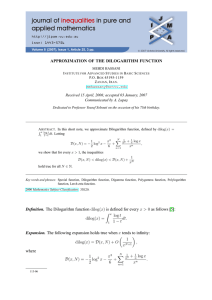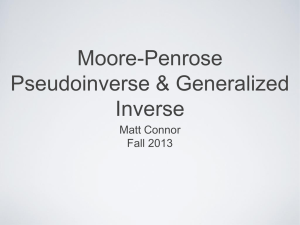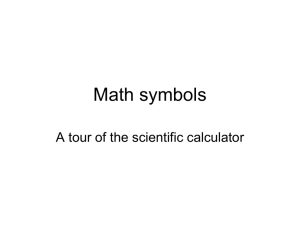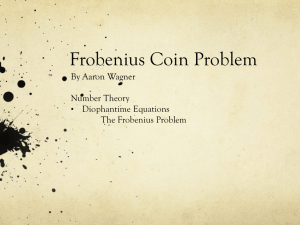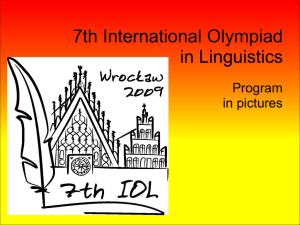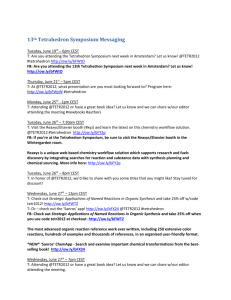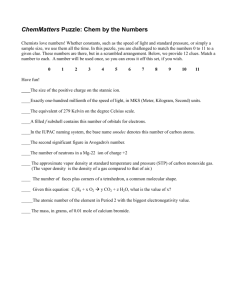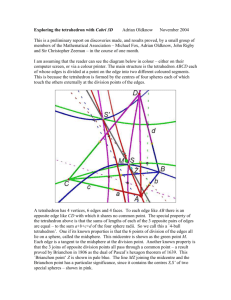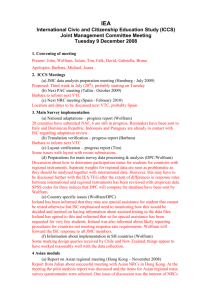Course Notes
advertisement
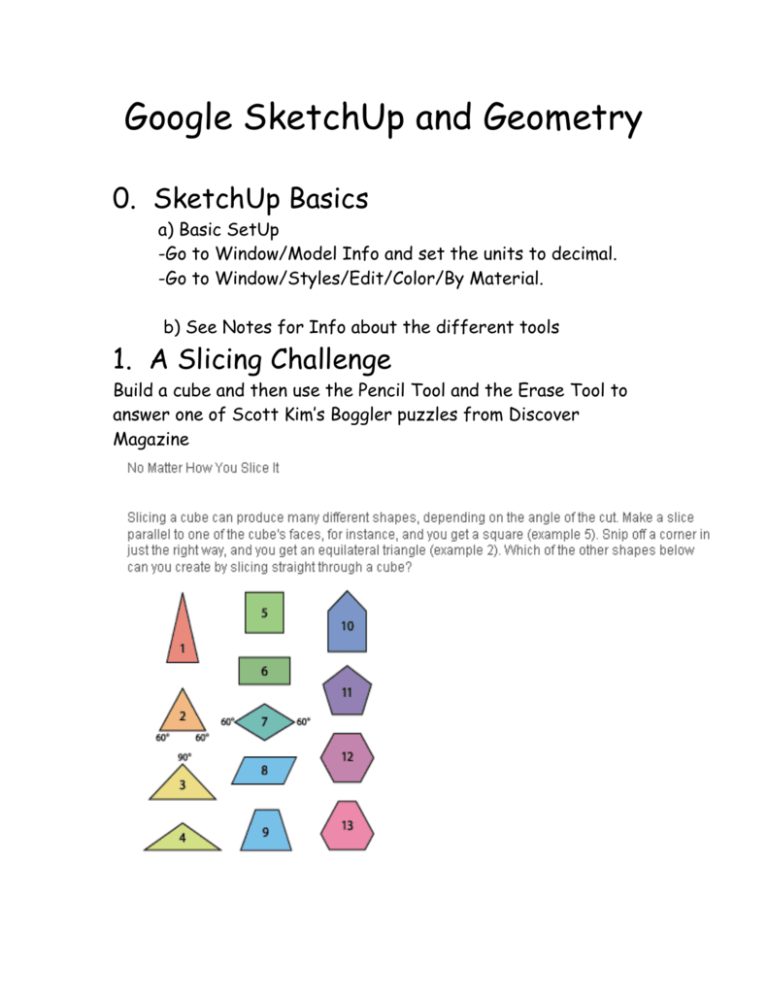
Google SketchUp and Geometry 0. SketchUp Basics a) Basic SetUp -Go to Window/Model Info and set the units to decimal. -Go to Window/Styles/Edit/Color/By Material. b) See Notes for Info about the different tools 1. A Slicing Challenge Build a cube and then use the Pencil Tool and the Erase Tool to answer one of Scott Kim’s Boggler puzzles from Discover Magazine 2. An Interesting Design Problem The Stanford Puzzle Problem i) Construct a 200 x 100 x 700 rectangle with a circular hole that has a diameter of 100 units, an isosceles triangular hole with a base an a height of 100 units and a square hole 100 units on a side. ii) Use the push/pull tool to create a box with a height of 100 units iii) Create a solid object that will fit through each hole and which will completely block light. 3. Traditional Constructions a) Using Circles Be sure to increase the number of sides. b) Using Parallels and Perpendiculars SketchUp will tell you while dragging when a segment under construction is either parallel or perpendicular to an existing segment. 4. Some Useful Constructions and Demonstrations a) Show that a cube can be dissected into three congruent tri rectangular pyramids. b) Show that a regular tetrahedron can be dissected into an octahedron and four tetrahedron all with the same edge length. This can be used to show an interesting relationship between the volume of an octahedron and that of a tetrahedron. c) Intersect a cone with a plane to show the different conic sections. d) Building a pyramid from a net. e) Diagram for calculating dihedral angles for polyhedra. 5. A Course in Symmetry a) Symmetry in 2D http://www.peda.com/tess/ i) Rosette http://www.geom.uiuc.edu/java/Kali/program.html ii) On a Strip http://www.geom.uiuc.edu/java/Kali/program.html http://convergence.mathdl.org/images/upload_library/4/vol1/architec ture/Math/seven.html iii) In the Plane: Wallpaper Groups http://www.oswego.edu/~baloglou/103/seventeen.html http://www.scienceu.com/geometry/articles/tiling/wallpaper.html iv) Escher’s Wonderful Patterns http://www.mcescher.com/Gallery/gallery-symmetry.htm http://www.tessellations.org/ http://library.thinkquest.org/16661/escher/tessellations.1.html b) Symmetry in 3D i) Rotational and Mirror http://www.geom.uiuc.edu/~teach95/kt95/KTL.html b) Tilings and Tesselations i) A Polygonal Periodic Approach 1) Regular http://library.thinkquest.org/16661/simple.of.regular.polygons/regular .1.html 2) Semi-Regular http://library.thinkquest.org/16661/simple.of.regular.polygons/semire gular.1.html 3) Demi-Regular http://library.thinkquest.org/16661/of.regular.polygons/demiregular.1. html 2) A Polygonal Aperiodic Approach http://www.spsu.edu/math/tile/aperiodic/index.htm i) Hirschhorn and Voderberg Tiles http://www.uwgb.edu/DutchS/symmetry/radspir1.htm ii) Penrose Tiles http://www.ams.org/featurecolumn/archive/penrose.html iii) The Spidron System http://www.szinhaz.hu/edan/SpidroNew/ c) Polyhedra 1) Prisms and Pyramids http://mathworld.wolfram.com/Prism.html http://mathworld.wolfram.com/Antiprism.html http://mathworld.wolfram.com/Pyramid.html 2) The Platonic Solids http://mathworld.wolfram.com/PlatonicSolid.html http://www.geometrycode.com/sg/polyhedra.shtml 3) The Archimedean Solids http://mathworld.wolfram.com/ArchimedeanSolid.html 4) The Catalan Solids http://mathworld.wolfram.com/CatalanSolid.html 5) Compound Polyhedra http://en.wikipedia.org/wiki/Polyhedral_compound 6. Tetrahedral Geometry http://www.ac-noumea.nc/maths/amc/polyhedr/tetra_.htm a) Every tetrahedon has a centroid. QuickTime™ and a TIFF (Uncompressed) decompressor are needed to see this picture. b) Every tetrahedron has an incenter, a circumcenter and four excenters. c) Every tetrahedron has a special point known as the Monge Point which is the intersection of the six planes that are perpendicular to a given edge and pass through the midpoint of the opposite edge. d) De Gua’s Theorem QuickTime™ and a TIFF (Uncompressed) decompressor are needed to see this picture. e) Bang’s Theorem QuickTime™ and a TIFF (Uncompressed) decompressor are needed to see this picture. f) Othocentric Tetrahedra • the four altitudes are convergent (existence of an orthocentre H) • the three pairs of opposite edges are orthogonal (characteristic property) • the feet of the altitudes are orthocentres of the faces • the three common perpendicular to opposite edges are convergent in H • the three segments joining the midpoints of opposite edges have same length • the midpoints of the edges and the feet of the common perpendiculars to opposite edges lay on a sphere with centre the isobarycentre G of the vertices (first Euler's sphere) • with O centre of the circumscribed sphere, G is midpoint of [OH] (Euler's line of the tetrahedron) • the perpendiculars to the faces in their centres of gravity are convergent in I on the Euler's line • in a tetrahedron ABCD, the feet of the altitudes, the centres of gravity of the faces, and the points laying on the thirds of [HA], [HB], [HC] and [HD] lay on a sphere with centre the midpoint of [HI] (second Euler's sphere) • in a tetrahedron ABCD, AB²+ CD² = AD²+ BC² examples: the regular tetrahedra, the trirectangle tetrahedral http://www.ac-noumea.nc/maths/amc/polyhedr/tetra_.htm
